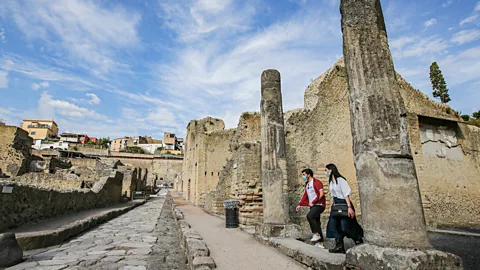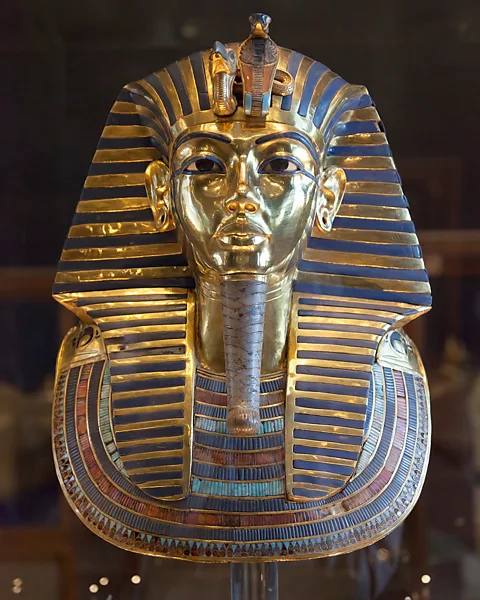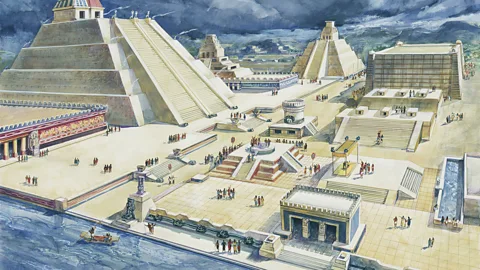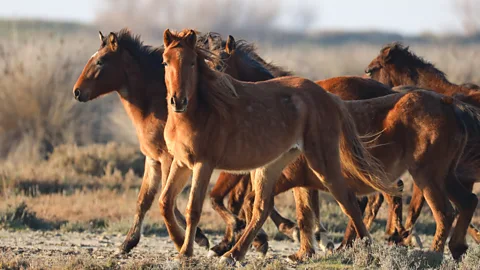Why some ancient societies were more unequal than others
 Zde/Wikimedia Commons/CC BY-SA 4.0
Zde/Wikimedia Commons/CC BY-SA 4.0Inequality affected some ancient societies, but not all. Changes in farming – and the animals used in it – might have been a factor which caused it to spiral.
26 November 1922 marks what is arguably the most famous discovery in the history of archaeology. On that day, the British Egyptologist Howard Carter made a small hole through which he could insert a candle in the sealed doorway of Tutankhamun's burial chamber and thus lit the interior. As his eyes slowly adapted to the darkness, he was able to make out a chamber that had not been disturbed for over 3,000 years.
Tutankhamun was just an obscure pharaoh during his lifetime, and there is evidence that he was hastily buried – the second of the three nested coffins seems to have originally belonged to someone else. And yet the inner coffin, in which his mummy was discovered, is made of solid gold, weighing almost 250lbs (113kg). One can barely imagine how impressive the burials of such powerful leaders as Khufu, Thutmose III, or Rameses II must have been. Alas, they were all looted in antiquity.
But contrary to popular belief and cinematic glorification, most archaeologists would say that the search for spectacular treasures isn't their main research objective. They want to understand the daily life of past civilisations. Still, both extremes – the fabulous wealth of kings and the hardscrabble existence of common people – contribute to an understanding of what can be argued is one of the main goals of archaeology: to document and study the evolution of inequality in ancient societies. This also involves the question of how to recognise and quantify it.
One of the most obvious approaches would be through the assessment of differential goods deposited in graves. But richly furnished graves may not simply be evidence of social differentiation; rather, they may be an attempt to demonstrate the importance and distinction of a family in relationship to other kindreds – a social importance that may not exist in reality. Moreover, social stratification can be based on wealth but can also be based on personal prestige and power. Therefore, it isn't always possible to assess social differences by comparing graves with goods to those without them.
Some archaeologists have attempted to apply economic principles to examine social differences at specific sites and, crucially, compare the data from different places. A study led by Samuel Bowles from the Santa Fe Institute and published in Nature in 2017 tried to address this question by applying the Gini coefficient – a single number most commonly used to measure income inequality – across a large number of sites from the archaeological record, both in the Old World and the Americas.
You might also like:
The list of sites included paradigmatic cities such as Çatalhöyük in Turkey, Pompeii in Italy, and Teotihuacan in Mexico – the authors measured the dimensions of houses as estimated indicators of wealth.
Among modern hunter-gatherers, the team found, the Gini coefficient is low – around 17 (on a scale of 0 to 100). This is not surprising as few objects can be carried in nomadic societies, and consequently, personal qualities such as the ability to hunt count for more. This does not mean that some people didn't have a higher social status; material culture was probably so poor – or so different from our perceptions of status – that it is difficult to grasp social differences among past hunter-gatherers.
 Antonio Balasco/Kontrolab/ via Getty Images
Antonio Balasco/Kontrolab/ via Getty ImagesIn the ancient farming societies under study the Gini coefficients are estimated to have been between 35 and 46. Interestingly, the real measurements were lower than those obtained from records. For instance, among the ruins of Babylonia, researchers estimated a coefficient of 40, yet an estimate based on information from the Babylonian chronicles resulted in a higher coefficient of 46. The ancient accounts likely overemphasised the size of the largest houses in admiration. This is not unlike what happens when we return from a trip: we sometimes tend to exaggerate the things that we've seen.
Nevertheless, the most remarkable differences come from the comparison of the societies of the Old World and those of the Americas, with the latter being much more equal in the Gini coefficient, despite being highly hierarchical in some cases such as the mighty Aztec Empire. Researchers conclude that the root of these differences could be ecological, since there were more and larger animals to be domesticated in Eurasia – such as cows, horses, pigs, sheep, and goats – than in the Americas, with only dogs and turkeys, and this trait alone created a differential system of accumulated wealth.
At the Aztec capital, Tenochtitlán, for instance, houses had highly standardised dimensions and were all quite similar. Aztec society, even with its horrific human sacrifices, was at the time of the Spanish Conquest more egalitarian than Mexico 200 years later, when the European elite had created the encomienda system, under which the indigenous population worked in semi-slavery. Within a few generations, the concentration of wealth had almost doubled in the colonial New World, with a consequent increase in inequality.
When did these differences between the Old and New Worlds emerge? Early farming societies had the possibility of generating and storing food surpluses, creating potential scenarios for differences in population size along with a certain degree of inter- and intrasettlement inequality. A recent application of the Gini coefficient to 90 sites from the Near East and Europe showed a remarkable increase of inequality thousands of years after the advent of agriculture – a finding that would indicate it was not farming per se that created unequal societies.
 Roland Unger/Wikimedia Commons/CC BY-SA 3.0
Roland Unger/Wikimedia Commons/CC BY-SA 3.0According to the authors, at some point some farmers were able to maintain specialised plough oxen that could cultivate 10 times more land than other farmers, thereby transforming the economy toward a higher value of land in detriment of human labour.
This emerging inequality at the end of the Neolithic could explain a remarkable example of wealth dating from that period: the Varna burial. This burial was found in a Copper Age cemetery in modern Bulgaria and is dated to 4560–4450BC. It contained more gold than the rest of the world possessed at that time. With it were the remains of an adult male – likely a chieftain or king of some sort – who was buried holding a gold war mace. Curiously, he also had a gold penis sheath of unknown meaning. Still, such findings are exceptional, and there is a general consensus that Neolithic societies were more egalitarian than later ones.
Inequality clearly increased with the arrival of metals, which partly allowed, from 3000 to 2000BC onward, the appearance and development of a social organisation based on the emergence of elites. Once the initial power structure was established, it attempted to perpetuate itself dynastically by increasing social control and building up familial alliances with other chiefs.
Control mechanisms often involved violence. The possibility of using horses – and to lesser extent, camels – as instruments of war determined the success of conquests that would alter the pattern of settlements across Eurasia at the end of the Neolithic. This would at least partially explain how 30 empires or large states that emerged between 3000 and 600BC were all found in the Old World, where these animals roamed.
Consequently, tombs with signs of wealth became more abundant in the archaeological record, such as the famous Amesbury Archer, found three miles southeast of Stonehenge in 2002 (near today's Salisbury) and dated to 2300BC. This grave includes more artifacts than any other Bronze Age British burial. Besides numerous arrowheads, three copper knives, four boar's tusks, two stone wrist guards that protected users from their bowstrings, and five pots that conformed to the Bell Beaker tradition, there were two gold hair ornaments – the earliest pieces made of this metal ever found in the British Isles.
The arrival of the Bell Beaker complex to the British Isles is associated with an almost complete replacement of the prior local population and subsequent emergence of social elites.
 DEA Picture Library/De Agostini via Getty Images
DEA Picture Library/De Agostini via Getty ImagesThe rise in inequality during this period, both in the Middle East and parts of western Europe, seems to be partly influenced by an increase in population density. This correlation is likely related to a growing complexity in modes of subsistence, trading networks, and political organisation associated with population growth.
Although the highest Gini coefficients for past societies determined by the Santa Fe Institute were similar to those found in some present-day European countries (for instance, with values of around 60 in Pompeii and Kahun, an Egyptian settlement from the 12th Dynasty), they remained below the values for the most unequal modern societies such as China and the United States (with Gini coefficients of 73 and 85, respectively), which obviously have larger populations.
From a historical perspective this would suggest that an increase in population size brings higher inequality – an issue explored by the economist Thomas Piketty in recent times, but that likely has parallels in Bronze Age populations.
Still, the Gini coefficient cannot always be applied since some settlements have grown with time over the destruction of previous ones, piled one atop another like the layers of a cake. Many ancient sites could not possibly be studied in detail. For instance, at Hisarlik – the old Troy – at least 10 cities arose atop their predecessors in just 2,000 years, making them quite difficult to disentangle. In addition to this limitation, whether the Gini coefficient can be transferred between different cultural, geographic, and ecological environments to make direct comparisons has also been a subject of debate since such factors can influence their inhabitants differently. For example, a settlement established in a jagged terrain would favour smaller, more vertical houses than one extending over a vast plain.
The economic interpretation of past settlements has received some criticism from among the archaeological community. Some argue that the quality and solidity of the building materials can be as important as the size of the houses. In our modern cities, we're all aware that location – for instance, close to the city centre – is usually more important than size. Finally, the ostentatious wealth – opulent furniture, wall paintings, mosaics, and so on – that can still be found in some excavated houses such as at Pompeii should be taken into consideration too, though such features aren't usually well preserved.
 Werner Forman/UIG/Getty Images
Werner Forman/UIG/Getty ImagesOne way around these limitations might be to compare the Gini coefficients with the so-called health inequality of each population, since buried human remains are sometimes better preserved than buildings. There are several skeletal indicators (dental cavities, arthrosis, traumas, vitamin deficiencies, etc) that can reflect the health status of the population in each period. The frequencies of these pathological markers are in general higher during periods of higher inequality.
For example, the 2006–2013 excavation of cemeteries such as North Tombs Cemeteries at Amarna (an Ancient Egyptian site dating from 1346BC) demonstrated deaths at an early age – mainly of children, teenagers, and young adults – widespread dietary deficiencies, and indications of hard labour, suggesting the poor state of health and substandard working conditions for most of this urban community. For instance, 16% of all children under 15-years-old displayed spine injuries of the sort associated with carrying heavy loads; none of them had any grave goods, and sometimes were buried together with several others, with scant regard for the disposition of the bodies – a grim image that contrasts with the glamorous depictions of the pharaoh's family in the Amarna style.
An additional indicator would be evidence of a high infant mortality rate, although the preservation of children's skeletal remains is invariably more difficult than that of adult bones due to differential conservation processes, and this could represent an insurmountable bias in the results. Changes in health status can be used to ascertain cultural and ancestral transitions too. In this sense, probably the most striking change observed is between hunter-gatherers and the first farmers in Europe. The latter not only show signs of poorer health – such as cavities, almost unknown by the former – but also higher infant mortality rates and even lower stature than previous hunter-gatherers.
Correlated with this information, recent developments in the stable isotope analysis of carbon and nitrogen ratios in bone collagen can provide information on nutritional status and mobility patterns associated with specific individuals. For instance, the analysis of a high-status burial in Helmsdorf, Germany, related to the Únêtice culture, showed that this person had a higher protein intake than other contemporaneous peers, suggesting as well that diet can be as much an indicator of social status as it is in today's societies.
Key to understanding the social panorama of the past is that ancient cemeteries can provide not only potential indicators of inequality in the form of grave goods and even differential health status but also genetic material preserved within human remains. The information retrieved from their DNA can be used, for the first time, to correlate ancestry with social power in each period. Furthermore, a crucial aspect of the accumulation of power is the possibility of bequeathing wealth to biological relatives – something that can be tested as well via the interface between genetics and archaeology, which enables us to reveal family links.
 Lokman Ilhan/Anadolu Agency via Getty Images
Lokman Ilhan/Anadolu Agency via Getty ImagesLike funerary goods, a privileged resting place could serve as a status marker too. Around 6,500 years ago, the phenomenon of building large funerary stone structures – known as megalithic tombs – emerged, mainly across Europe's Atlantic seaboard, and culminated in the great passage tomb complexes such as Newgrange in Boyne Valley (Ireland), which has a mound almost 300ft (91m) in diameter and 50ft (15m). The origins and meaning of these monuments, which required a heavy investment in labour, have been debated for more than a century, as has the social organisation of the farming communities that built them. The genetic analysis of two-dozen individuals found in various megalithic tombs from Scandinavia to Orkney Island and Ireland yielded some interesting social clues.
In some places, notably the British Isles, more males than females were buried in these preeminent spots, pointing to a sex bias. In accordance with this observation, the descent of most individuals with kinship links could be traced through the paternal line. In one case it was possible to find two related males buried in two different megaliths just over a mile apart (Primrose Grange and Carrowmore in Ireland), indicating a geographic expansion of these dominant families. Genetic analyses of skeletal remains discovered within the most intricately constructed chamber of the Newgrange passage tomb revealed that they belonged to the incestuous son of a brother and sister (or a parent and child), and therefore a quarter of his genome had no genetic variation.
This kind of first-degree offspring is extraordinary, only having been cited in royal families of the past headed by god-kings such as the Egyptian pharaohs seeking to maintain a pure dynastic bloodline. (It is known, for instance, that Akhenaten married his eldest daughter, Meritaten, and much later, Ptolemy II married his sister, Arsinoe II – hence his nickname, "Philadelphus" or "sibling loving.") It has been suggested that this Neolithic elite may have claimed to possess divine powers to ensure the continuity of agricultural cycles by keeping the Sun's movements going.
The findings support the notion that these Neolithic communities were socially stratified and that the massive stone structures were used to bury transgenerational patrilineal members of these clans. Perhaps equally interesting is the fact that in one case relatives were separated by up to 12 generations, pointing to an unusual stability through time of both the funerary tradition and the stratified society where they lived.
We have seen several case studies of past inequality correlating funerary archaeology with genetics that might no longer apply today, where legal regulations (and also the exponential increase of cremations) represent a certain degree of standardisation in funeral practices. Nevertheless, an opposite trend could shape the future of the archaeology of death: the trend toward personalised coffins, unconventional funerary memorials, and special grave goods. One way or another, mortuary archaeology will always be an important subfield of this discipline, and one that will need to rely on the hard sciences such as genetics and forensics.
Perhaps one encouraging conclusion is that despite what we have seen on the archaeology of past inequality, societies have been able to evolve and change their social stratifications. One example is Iceland – the country has become one of the most egalitarian societies in the world. In 2018, Iceland passed a law that all companies employing more than 25 people will have four years to ensure gender-equal payment because, according to the head of the Equality Unit at Iceland's Welfare Ministry, "equality won't come about by itself, from the bottom up alone".
* This is an edited version of an article that originally appeared in The MIT Press Reader, and is republished with permission.
--
Carles Lalueza-Fox is Research Professor and Director of the Paleogenomics Lab at the Institute of Evolutionary Biology (CSIC-Universitat Pompeu Fabra) in Barcelona. He participated in the Neanderthal Genome Project and led the first retrieval of the genome of an 8,000-year-old European hunter-gatherer. He is the author of Inequality: A Genetic History, from which this article is adapted (this is an edited version of the original MIT Reader piece).
--
If you liked this story, sign up for the weekly bbc.com features newsletter, called "The Essential List" – a handpicked selection of stories from BBC Future, Culture, Worklife, Travel and Reel delivered to your inbox every Friday.
